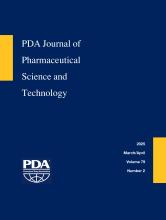Abstract
Active and passive air monitoring is crucial for gaining knowledge about the microbial status of cleanroom environments for aseptic processing. Most agencies require active air monitoring of defined volumes in short time periods. However, active air monitoring methods may disrupt the unidirectional airflow of filtered air and are therefore difficult to use for continuous air monitoring. Hence, settle plates are additionally placed at areas of high risk during the whole filling process including set-up. While EU GMP Annex 1 9.30 defines a maximum duration of 4 hours for settle plates with a diameter of 90 mm and <USP 1116> defines a maximum of 4 to 5 hours respectively, there are no recommendations for settle plates with a diameter of 150 mm. Agencies expect validation studies including recovery rates as a basis to determine the exposure time. This study provides data showing that settle plates with a diameter of 150 mm can be placed under unidirectional airflow for up to 8 hours in a cleanroom with moderate humidity. No negative effect on the suitability of the media was observed. Moreover, it is shown that, settle plates with a diameter of 150 mm can be exposed to unidirectional airflow for up to 6 hours in a cleanroom with very low humidity as used for aseptic filling of lyophilized products. Increased exposure times of settle plates for up to 6 respectively 8 hours significantly reduce the exchange frequency of settle plates, which ultimately lowers the risk from microbial contamination during filling due to less interventions.
- Environmental Monitoring
- settle plates
- exposure time
- Cleanrooms
- laminar airflow
- microorganisms
- microbial recovery
- Received November 14, 2024.
- Revision received March 24, 2025.
- Accepted April 22, 2025.
- Copyright © 2025, Parenteral Drug Association
PDA members receive access to all articles published in the current year and previous volume year. Institutional subscribers received access to all content. Log in below to receive access to this article if you are either of these.
If you are neither or you are a PDA member trying to access an article outside of your membership license, then you must purchase access to this article (below). If you do not have a username or password for JPST, you will be required to create an account prior to purchasing.
Full issue PDFs are for PDA members only.
Note to pda.org users
The PDA and PDA bookstore websites (www.pda.org and www.pda.org/bookstore) are separate websites from the PDA JPST website. When you first join PDA, your initial UserID and Password are sent to HighWirePress to create your PDA JPST account. Subsequent UserrID and Password changes required at the PDA websites will not pass on to PDA JPST and vice versa. If you forget your PDA JPST UserID and/or Password, you can request help to retrieve UserID and reset Password below.






